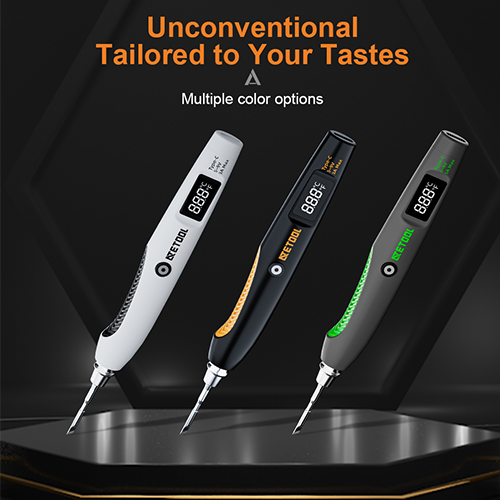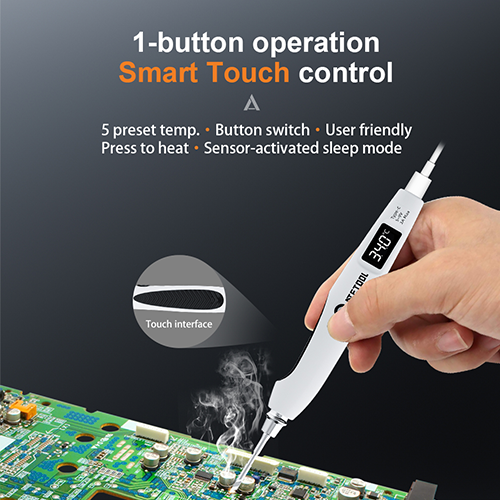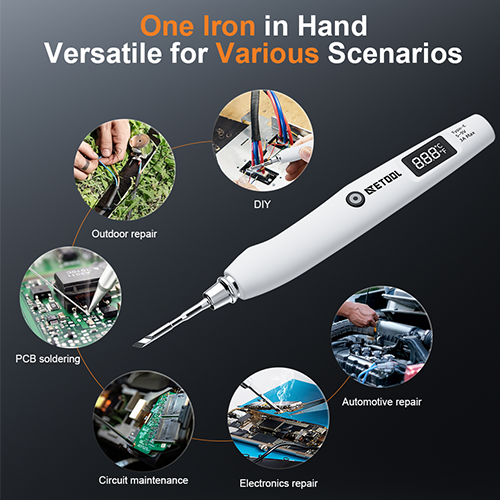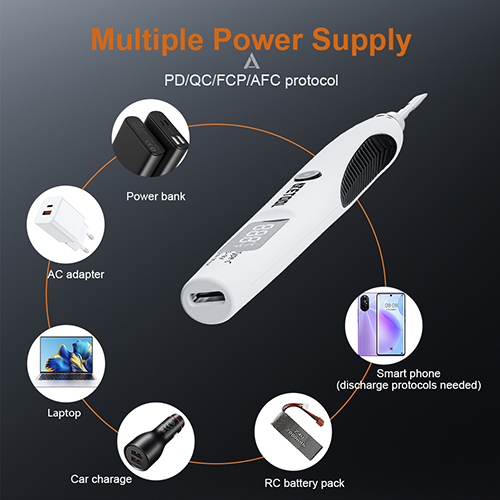
Hey there, soldering enthusiasts! Whether you're a DIY hobbyist, a repair guru, or a pro in the electronics industry, a handheld soldering iron is your best friend. Imagine having a tool that fits right in your hand, ready to tackle anything from intricate circuit boards to simple home repairs. That’s the magic of a handheld soldering iron – it’s all about precision, portability, and power packed into one nifty gadget.
In this article, we’re diving deep into the world of handheld soldering irons. We'll cover everything from what makes these tools tick to why they’re a must-have in your toolkit. If you’re on the hunt for the best portable soldering iron, looking to start a new DIY project, or just curious about the hype, you’re in the right place. Ready to spark up some knowledge? Let’s get started!
So, what exactly is a handheld soldering iron? Think of it as the Swiss Army knife of the soldering world. A handheld soldering iron is a compact, portable tool designed for joining metal parts together. It's the go-to device for anyone who needs precision and mobility in their soldering tasks.
At its core, a handheld soldering iron consists of a heated metal tip and an insulated handle. The tip gets hot enough to melt solder, a fusible metal alloy used to create a permanent bond between metal workpieces. Unlike bulky soldering stations, handheld versions are lightweight and easy to maneuver, making them perfect for on-the-go tasks.
You might be wondering, how does a handheld soldering iron stack up against other types? Let’s break it down:
Portability: Handheld soldering irons are designed for convenience. They’re lightweight and often battery-powered, making them ideal for fieldwork or quick fixes at home.
Size: These tools are generally smaller, which means you can get into tight spaces that larger, stationary soldering irons can’t reach.
Versatility: While soldering stations offer more power and features for heavy-duty tasks, handheld soldering irons are versatile enough for a wide range of applications, from electronics to jewelry making.
Cost: Handheld models are usually more affordable, which is great if you’re just starting out or need a budget-friendly option.
In essence, if you need a reliable tool that’s easy to carry and gets the job done, a handheld soldering iron is the way to go. It’s like having a trusty sidekick that’s always ready to help, whether you’re fixing a gadget, crafting a piece of art, or teaching a class on electronics.

Alright, now that we've got the basics down, let's dig into why a handheld soldering iron might just be your next best purchase. What makes these little tools so special, and why are they becoming a staple in workshops and toolkits around the world?
First off, let's talk about the sheer convenience of a handheld soldering iron. These tools are designed with mobility in mind. Need to fix a loose wire on your car’s battery? No problem. Want to repair a circuit board without lugging around a heavy station? Easy peasy. Handheld soldering irons give you the freedom to move around and work in places where traditional soldering stations can't go.
Another big plus is their portability. Most handheld soldering irons are lightweight and compact, which means you can easily toss them into your toolbox or even your pocket. This makes them perfect for quick repairs on the go or for situations where space is at a premium.
Speaking of ease of use, handheld soldering irons are incredibly user-friendly. They usually feature a simple on/off switch and a quick heat-up time, so you can get to work right away. Many models are also battery-operated, eliminating the need for a power outlet. This is a game-changer for fieldwork or when you’re working on a project outdoors.
But wait, there’s more! Handheld soldering irons are versatile. They can be used for a wide range of applications, from delicate electronics work to heavier tasks like metalwork and plumbing repairs. Whether you’re a professional, a hobbyist, or somewhere in between, a handheld soldering iron can handle almost anything you throw at it. It's like having a magic wand that can fix, build, and create.
In short, a handheld soldering iron is an invaluable tool that offers convenience, portability, and versatility, making it an excellent choice for anyone looking to tackle a variety of soldering projects.
Now, let’s get into the nitty-gritty – finding the best portable soldering iron for your needs. With so many options out there, it can be tough to know where to start. Don't worry; we’ve got you covered. Here’s a rundown of some of the top models currently making waves in the market.
Pinecil Smart Mini Portable Soldering Iron
This little powerhouse is known for its smart features and portability. It heats up quickly and comes with adjustable temperature settings, making it ideal for precision work.
Hakko FX-901/P Cordless Soldering Iron
The Hakko FX-901/P is a cordless wonder. It’s battery-operated, which makes it perfect for on-the-go repairs. Plus, it offers a comfortable grip and reliable performance.
ATETOOL AE730D USB Soldering Iron
ATETOOL is a trusted name in the soldering world, and AE730D USB soldering iron lives up to the hype. This model is type C port powered, giving you the flexibility to work anywhere without worrying about power source, like phone charger, power bank, battery packs, laptop, and even your smart phone, etc.

When choosing a handheld soldering iron, consider these key features:
Heat-Up Time: Look for models that heat up quickly to save time on your projects.
Temperature Control: Adjustable temperature settings allow for more precise work, especially on delicate components.
Power Source: Decide between battery-operated, butane-powered, or USB-rechargeable models based on your needs.
Ergonomics: A comfortable grip is essential for extended use and precision.
Don’t just take our word for it – check out what other users have to say. Online reviews and ratings can provide valuable insights into a product’s performance, durability, and ease of use. Look for models with consistently high ratings and positive feedback.
By considering these factors, you can find a handheld soldering iron that meets your specific needs and preferences, ensuring that you have the right tool for the job every time.
When it comes to electronics, precision is key. A handheld soldering iron is an essential tool for anyone working with electronic components, whether you’re a professional engineer, a student, or a hobbyist. Let’s explore why handheld soldering irons are a great fit for electronics and how to choose the right one.
Handheld soldering irons are incredibly versatile and can be used for a wide range of tasks in electronics, such as:
Circuit Board Repairs: Fixing broken traces, replacing components, and soldering wires to boards.
Prototyping: Assembling and modifying prototypes quickly and efficiently.
DIY Electronics Projects: Building gadgets, custom electronics, and small robots.
Connector and Wire Soldering: Attaching connectors and repairing wires in electronic devices.
The compact size and precise control of handheld soldering irons make them ideal for these delicate tasks, where accuracy is crucial.

When choosing a handheld soldering iron for electronics, consider the following tips:
Temperature Control: Look for models with adjustable temperature settings. Different electronic components require different soldering temperatures.
Fine Tips: Ensure the soldering iron comes with fine, replaceable tips for detailed work.
ESD Safety: Electrostatic discharge (ESD) can damage sensitive electronic components. Choose an ESD-safe soldering iron if you’re working with sensitive electronics.
Portability: A battery-powered or USB-rechargeable model can be very convenient for working in different locations or on-the-go repairs.
Working with a soldering iron involves high temperatures, so safety is paramount. Here are some precautions to keep in mind:
Work in a Well-Ventilated Area: Solder fumes can be harmful, so ensure good ventilation or use a fume extractor.
Use Proper Tools: Use a soldering stand to hold the hot iron when not in use and wear safety glasses to protect your eyes from solder splashes.
Be Mindful of ESD: Ground yourself and your work area to prevent static electricity from damaging sensitive components.
By following these tips and precautions, you can safely and effectively use a handheld soldering iron for all your electronic projects.
One of the most exciting aspects of owning a handheld soldering iron is the ability to dive into a variety of DIY projects. From simple repairs to creative inventions, the possibilities are endless. Let’s explore some popular DIY projects you can tackle with your handheld soldering iron and some tips to get you started.
Here are a few DIY projects that are perfect for beginners and seasoned pros alike:
Repairing Headphones: Fix broken headphone wires or replace the jack to extend the life of your favorite pair.
Building a Custom LED Lamp: Create a unique LED lamp for your desk or workspace by soldering LEDs, resistors, and a power source.
Creating a Solar-Powered Charger: Combine solar panels, a battery, and a USB port to build your own portable solar charger.
Modding Game Consoles: Enhance your gaming experience by adding custom lighting, cooling mods, or new features to your console.
Let’s take a closer look at one of these projects: repairing headphones.
Gather Your Tools: You’ll need your handheld soldering iron, solder, heat shrink tubing, a wire stripper, and a replacement jack if needed.
Prepare the Wires: Cut off the damaged section of the headphone wire and strip the insulation from the ends of the wires.
Tin the Wires: Apply a small amount of solder to the exposed wire ends to make them easier to work with.
Solder the Wires: Connect the wires to the new jack or to each other, ensuring a secure connection. Use heat shrink tubing to insulate the soldered joints.
Test Your Repair: Plug in the headphones and check for sound quality. Make any necessary adjustments to ensure a good connection.
Don’t limit yourself to just repairs and basic projects. Get creative! Use your handheld soldering iron for:
Art Projects: Create intricate metal art by soldering pieces together.
Jewelry Making: Design custom jewelry pieces by soldering metal findings and embellishments.
Model Building: Assemble detailed models for hobbies like model trains, airplanes, or miniature dioramas.
Your handheld soldering iron is more than just a tool – it’s a gateway to creativity and innovation. With a little imagination, you can bring countless ideas to life and enjoy the satisfaction of building something with your own hands.

Now that you're all set with your handheld soldering iron, it’s crucial to keep it in tip-top shape. Proper maintenance not only extends the life of your tool but also ensures it performs efficiently every time you use it. Here’s how you can take care of your handheld soldering iron.
Regular cleaning is essential to keep your soldering iron working smoothly. Follow these steps to maintain your tool:
Clean the Tip: After each use, clean the soldering iron tip with a damp sponge or brass wire cleaner. This removes oxidation and solder residue, ensuring the tip stays in good condition.
Tin the Tip: Apply a thin layer of solder to the tip before storing it. This helps prevent oxidation and keeps the tip ready for the next use.
Check for Damage: Regularly inspect the tip and replace it if it becomes worn or damaged. A damaged tip can affect performance and make soldering more difficult.
Clean the Handle: Wipe down the handle and any accessible parts of the soldering iron to remove dust and debris.
Even with the best care, you might encounter some issues with your handheld soldering iron. Here are common problems and how to fix them:
Tip Not Heating Properly: Ensure the iron is plugged in and turned on. If it’s battery-powered, check the battery charge. Replace the tip if it’s worn out.
Solder Not Sticking: Make sure the tip is clean and properly tinned. Use the right type of solder for your project, and check that the components are clean.
Oxidation Buildup: Clean the tip regularly and use a tip activator or cleaner if necessary. Store the iron properly to minimize oxidation.
To get the most out of your handheld soldering iron, follow these best practices:
Store Properly: Keep your soldering iron in a cool, dry place. Use a stand to hold it when not in use and avoid leaving it plugged in for long periods.
Use Quality Accessories: Invest in good quality solder, tips, and accessories. Cheap materials can wear out quickly and damage your tool.
Avoid Overheating: Don’t leave the iron on for longer than necessary. Turn it off between uses to prevent overheating, which can damage the tip and other components.
By taking good care of your handheld soldering iron, you’ll ensure it remains a reliable and effective tool for all your soldering projects.
So there you have it – a comprehensive guide to handheld soldering irons! From understanding what makes these tools special to exploring their myriad uses and learning how to maintain them, you’re now well-equipped to make the most out of your handheld soldering iron.
Remember, whether you’re a DIY enthusiast, a professional in the electronics industry, or just someone who loves to tinker, a handheld soldering iron is a versatile and valuable addition to your toolkit. It’s like having a portable workshop in your pocket, ready to help you fix, create, and innovate wherever you go.
So why wait? Dive into your next project, repair that broken gadget, or create something entirely new. With your handheld soldering iron by your side, the possibilities are endless. Happy soldering!
Contact: Karen
Phone: (0086) 755 2340 8754 ext. 807
E-mail: atetool@atetool.com.cn
Add: 5F, 1-2# Building, Tongfuyu Industrial Zone, Aiqun Rd, Shiyan Subdistrict, Bao'an, Shenzhen, 518108, China